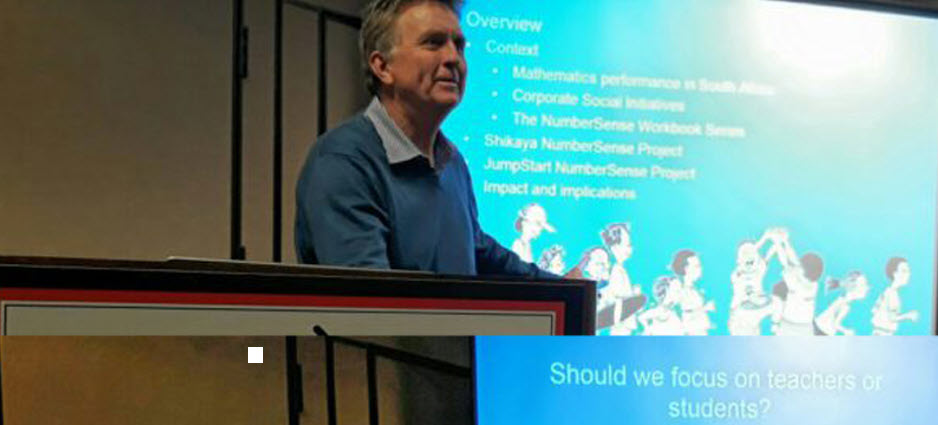Your cart is empty
- Home
- News
- Foundation Phase
- Should we focus on teachers or students?
Should we focus on teachers or students?

- Should we focus on teachers or students? The story of two approaches to address challenges in early grade mathematics learning in South Africa.
This is a research conference where Aarnout presented a paper on the research work involving two NumberSense Workbook programmes.
Aarnout Brombacher recently attended the CIES (Comparative and International Education Society) conference in Atlanta, GA, USA. This is a research conference where Aarnout presented a paper on the research work involving two NumberSense Workbook programmes. Below is the content of Aarnout’s presentation.
Should we focus on teachers or students? The story of two approaches to address challenges in early grade mathematics learning in South Africa.
Authors: Aarnout Brombacher (Brombacher and Associates), Stephen Mahony (The JumpStart Foundation Trust), Dylan Wray (Shikaya)
Low performance in early grade mathematics is endemic in South Africa. Of every 100 students who enter school in Grade 1, 60 attempt the national school leaving examinations 12 years later with 37 of the 60 being awarded a school leaving certificate (Van Broekhuizen, Van der Berg & Hofmeyr, 2016). Of the 37 that receive a school leaving certificate only 5 will have a sufficiently high score in mathematics to qualify for employment that relies on mathematics or which allows them to enrol for further study in mathematics. For many children their mathematics careers begin to falter at or about grade 4 level.
This paper reports on two different corporate social responsibility funded projects that use the same learning materials to support low socio-economic public schools to improve the performance of their early grade students in mathematics. Both projects are measuring the impact of their activity using a group administered (tablet based) assessment derived from the Early Grade Mathematics Assessment (EGMA).
The Shikaya NumberSense project focusses on the classroom teacher. Teachers in participating schools receive weekly classroom based coaching support. Coaching focusses on supporting teachers to implement a set of daily research based teaching routines in their early grade (grade 1 to 3) classes. The daily routines typically address counting, manipulating numbers and solving problems and are implemented on a differentiated bases, with children in the class receiving support that is aligned with their developmental level.
All teachers in participating schools also receive a kit with teaching aids. All students in participating schools are supplied with a set of workbooks. These page-a-day workbooks reflect the pedagogies that the teachers are being coached to implement in their classes and provide the opportunity for independent student work. Teachers are supported by the coaching staff to incorporate the workbooks into their lessons in such a way that the workbook activities reinforce the content of the daily lesson. This project employs 7 coaches (former teachers), is working in 12 schools, reaching 112 teachers and indirectly some 5 000 students.
The JumpStart NumberSense project focusses on students. Students in participating schools are supplied with a set of the same workbooks used in the Shikaya NumberSense project. Teachers in the participating schools typically receive a one day orientation on the philosophy and pedagogical approach of the workbooks and are provided with guidance on how they can incorporate the workbooks into their mathematics lessons. In some schools teachers also receive the same teaching aids kit mentioned above. Interns are used in the JumpStart NumberSense project to monitor progress by students as their work in the workbooks.
School leavers join the project as interns and receive a monthly stipend. Each intern receives training on how to monitor the progress of students through the workbooks and also on how to support students where possible (sometimes in after school classes). The key role of each intern is to visit each class in a school at least once per week. During a classroom visit the intern monitors the progress of the student in the workbook by (a) marking the work done by the students and (b) recording in a tablet based interface the number of pages completed by each student and the quality (poor, average, and good) of the work on the completed pages. The data submitted by the interns is aggregated and is used to monitor and manage the project activities. This project employs 20 interns, is working in 20 schools and reaches 13,000 students.
To ensure the efficacy of these donor-funded projects, information from routine monitoring is used to revise project approaches and/or provide additional support where needs are identified. In addition both projects are using the same tool to measure and monitor student progress.
Both projects are having a measurable impact on student performance. One project, however, appears to be having a greater impact on student performance than the other – at least after one to two years. The difference in the benefit that the students in the two projects appear to enjoy merits reflection on the focus of such projects – should we focus on teachers or students?